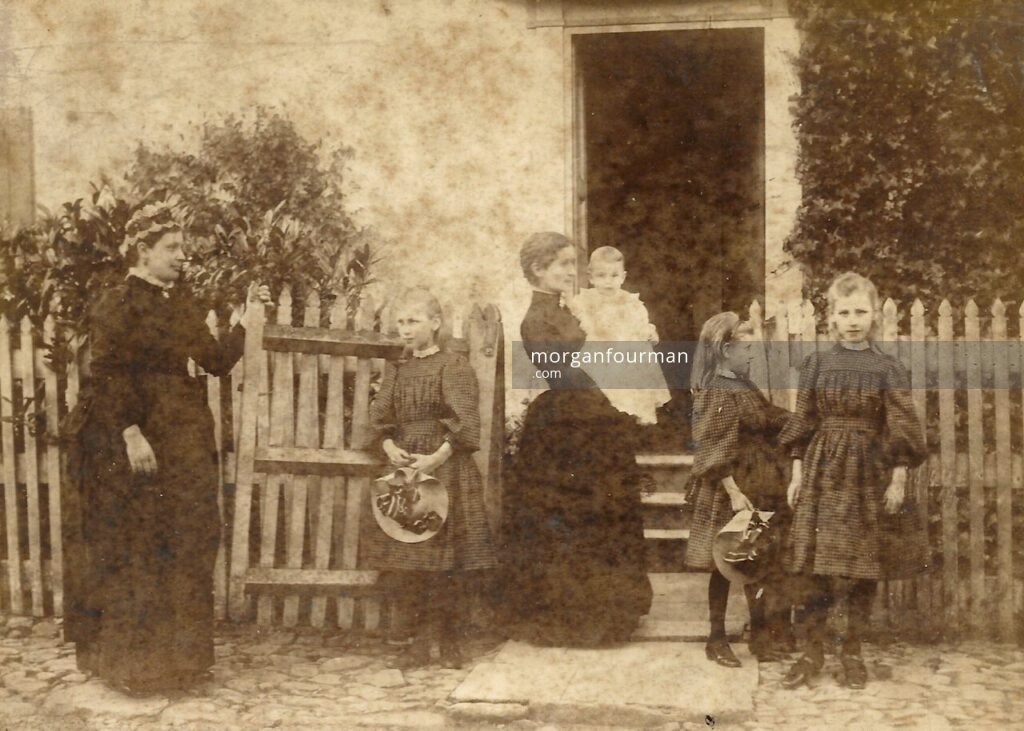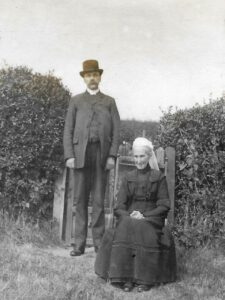Amongst the many Downing family photos there are a few references to Bishop’s Castle in Shropshire. The connection is all a bit of a mystery.
An early professional photo outside a building dates from 1889. It shows the four children of William Edmund Downing, the wealthy Smethwick maltster, and two unknown women. On the back, the photographer is stated to be W. L. Foster of Bishop’s Castle.

W. E. Downing’s children: May, Noel, Mary and Daisy, c. 1889. Photo by W. L. Foster, Bishop’s Castle
One of the connections with the town, ten miles south of Ratlinghope, was with the Reverend William Glenn (1835-1912). William Glenn was an Irish born Anglican priest who had three sons, all of whom served as clergy in the Church of England. For a long time William Glenn, lived in Bishop’s Castle and was Rector of Wentnor, just to the north of the town.
The photo in Mary Downing’s album entitled ‘Mrs Glenn and her son’ is dated 1913. This would be his widow Elizabeth Glenn, aged 78, and her son probably Thomas Robert Glenn. This son served for a time as Vicar of Ratlinghope after 1897. Another son William Edmund Glenn was Rector of Mainstone, just to the west of Bishop’s Castle.
The advowsons of at least one of these Rectorships was in the hands of the Scott family of Great Barr, but the Downing family who spent considerable time shooting and fishing at Ratlinghope, based in the Manor House there, seem to have a sustained relationship over a long period of time with the Glenns. These Rectors’ ‘livings’ clearly derived from the farms and rents in the area, all of which made the Glenns significant members of the local society.
An entry in Molly Downing’s diary a lot later makes the point. In May 1921 when the Downings arrive in Ratlinghope for a day’s fishing, their primary point of contact was the Rev Thomas Glenn and his daughter. At that time he was Rector of Habberley, Pontesbury further to the North of Ratlinghope.
Sources and Notes
- Crockford’s Clerical Directory, 1898, 1908 and 1932 – specifying tenure, patronage and value of the living of father and three sons, all serving as Anglican clerics. Richard John Glenn, the third son died 1904.
- William Lewis Foster was a Bishop’s Castle Photographer and Watchmaker (1891 census).
- The following 19th Century letter is quoted in Myndtown Parish Newsletter, 2015. It hung framed in the Three Tuns’ bar, Bishop’s Castle and is described as a glowing testimonial and an obvious solution to a Rector’s many problems. Dated 27 Mar 1899 it is addressed to Mr John Roberts, owner of Three Tuns, and written by the Rev William Glenn, then Rector of Wentnor:-
‘My dear Roberts, I hope you will not forget to send me some beer tomorrow (Tuesday) as I have not had a glass since I last saw you. Please send it good, as I shall have the Bishop and several clergy here on Monday week and you know there are no people in the world better judges of drink than they are. I want them to be able to exclaim as with one voice, after they have tasted your beer, “Roberts deserves well of his country as he is the only man who has discovered a Cure For Agricultural Depression”.
Yours truly, W. Glenn’ - It is perhaps not a coincidence that William Glenn’s eldest son shares the same names as those of Mr Downing.
- It is possible that the woman holding Noel Downing on the first photo is Elizabeth Glenn (nee Skelton) depicted twenty three years later on the second photo.
- The fact that William Edmund Downing’s daughter May was also to marry another Rector is perhaps testament to his keen interest in the patronage and Anglican appointments in Wales and the borders. The influence and money behind these preferments is opaque and the Anglican church was under huge pressure from the Non Conformist movement.
